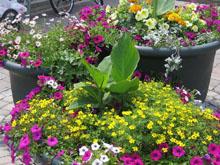How Do You Care for Container Plants?

Plants in containers can be used in the garden or on the patio, but they need extra care to do well.
Plants in containers provide gardeners with flexibility. They are a cost-effective way of brightening up a dull patio or adding interest to the garden. A few carefully selected containers can enhance both large and small gardens. Plants in pots can thrive but they need special attention as the soil in containers tends to dry out more quickly than it does in open ground.
The type of pot you choose will depend on the decor and colors used in your garden. Donít select a very large pot for a small plant. Start off with a smaller size and re-pot later as your plant grows. Before adding potting soil, give your container a good rinse with clean water. Make sure the drainage holes are open. Place some stones at the base of the pot to ensure good drainage. Commercial potting soil is best for potted plants, but you can a little liquid fertilizer and a water retaining polymer product at the time of planting.
How to care for container plants
Water is essential for the survival of your container plants. There is a definite balance between too much and too little. If the balance is off, your plant probably wonít survive. Some plants enjoy more water, while others prefer a good amount at less frequent intervals. Consult your nurseryman for further advice. Very hot, humid or windy weather dries out the soil in containers more quickly, so give your plants an extra drink during these weather conditions.
Container plants also need you to make sure that they receive the right nutrients to grow. Fertilizer isnít Ďplant foodí — plants make their own food through photosynthesis, but they need nutrients, water and sunlight to do so. There are various types of fertilizers you can choose for container plants, but always follow the dosage guidelines set out by the manufacturers. Overfeeding plants in containers wonít make them grow faster or stronger and may even kill them.
Choose a quality environmentally-friendly liquid or powder fertilizer specially formulated for pot plants. Some exotics require fertilizers with a special formulation. Acid-loving shrubs like azaleas and hydrangeas are two varieties that benefit from Ďtailor-madeí fertilizers. Plants can also take in vital nutrients through their leaves. Foliar feeds can be mixed with water and sprayed on to the leaves of plants.
Keep a careful check for insects that can damage your plants. Start a regular spray program to control them. If you donít want to use chemical pesticides, there are quality organic products on the market which produce good results.
How to re-pot a plant
Pot-bound plants look lacklustre, do not produce new growth or flowers and may have bunches of roots protruding from their drainage holes. If your container plants show any of these signs, itís time to pot-on.
Always choose a pot the next size up, donít use a much larger pot or the root system may not be able to cope with the sudden increase in surface area. Water the plant a few hours before you intend to re-pot it. Run a knife around the perimeter of the soil in the pot, and pry it loose. Gently break up some of the soil clumps around the roots and tease them out. Clean out the new pot, then add stones and potting soil. Place the plant you are re-potting at the same soil depth as it was in the old container. Water well and allow the plant to settle for a few days before adding fertilizer.
|